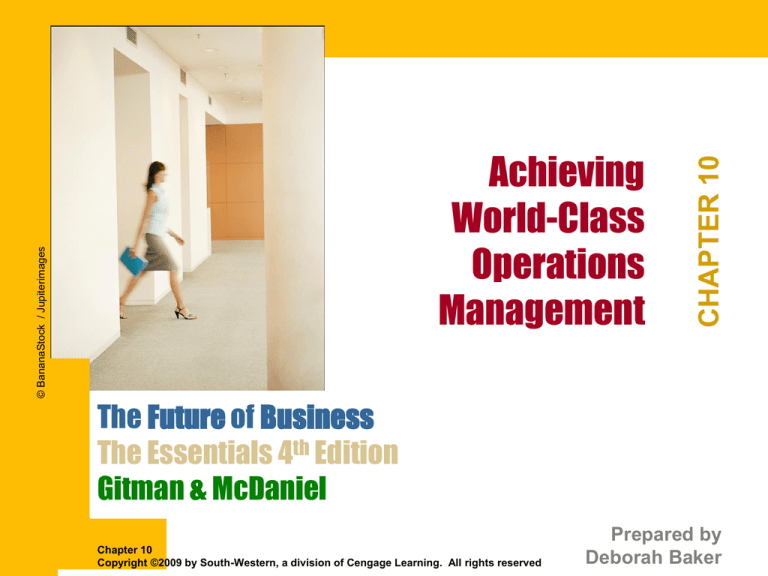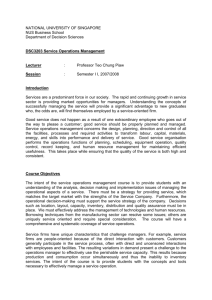
CHAPTER 10
© BananaStock / Jupiterimages
Achieving
World-Class
Operations
Management
The Future of Business
The Essentials 4th Edition
Gitman & McDaniel
Chapter 10
Copyright ©2009 by South-Western, a division of Cengage Learning. All rights reserved
Prepared by
Deborah Baker
CHAPTER 10
Learning Goals
1 Why is production and operations management
important in both manufacturing and service
firms?
2 What types of production processes do
manufacturers and service firms use?
3 How do organizations decide where to put their
production facilities? What choices must be
made in designing the facility?
4 Why are resource-planning tasks like inventory
management and supplier relations critical to
production?
2
CHAPTER 10
Learning Goals (continued)
5 How do operations managers schedule and
control production?
6 How can quality management and leanmanufacturing techniques help firms improve
production and operations management?
7 What roles do technology and automation play in
manufacturing and service industry operations
management?
8 What key trends are affecting the way companies
manage production and operations?
3
Production and Operations Management
1
1
Why is production and operations
management important in both
manufacturing and service firms?
4
Production and
Operations Management
production
The creation of products and services by turning
inputs into outputs, which are products and
services.
operations management
Management of the production process.
1
5
Production and Operations Management Decisions
1. Production planning
2. Production control
3. Improving production and operations
1
6
Production Planning
Short-Term
1 Year
1
Medium-Term
2 Years
Long-Term
3-5 Years
7
Production and Operations Management Decisions
Type of Production Process
Site selection
Facility layout
Resource planning
1
8
The Production Process:
How Do We Make It?
2
2
What types of production processes
do manufacturers and service firms use?
9
Production Process Classifications
1. How inputs are converted into outputs
2. Timing of the process
2
10
How Do We Make It?
mass production
The ability to manufacture many identical goods
at once.
mass customization
Goods are mass-produced up to a point, then
custom tailored to the needs of individual
customers.
customization
The production of goods or services one at a time
according to the needs of individual customers.
2
11
Converting Inputs to Outputs
process manufacturing
The basic input is broken down into one or more
outputs.
assembly process
The basic inputs are combined or transformed
into the output.
2
12
Production Timing
continuous process
A production process that uses long production
runs without equipment shutdowns.
intermittent process
A production process that uses short production
runs to make batches of different products.
2
13
Where Do We Make It?
3
3
How do organizations decide where to
put their production facilities?
What choices must be made in
designing the facility?
14
Where Do We Make It?
Availability of production inputs
Marketing factors
Manufacturing environment
Local incentives
International location
considerations
3
15
Designing the Facility
Process
Layout
3
Work flows according to the
production process
Product
Layout
Workstations or departments are
arranged in a line with products
moving along the line
Fixed-Position
Layout
The product stays in one place
and workers and machinery
move to it as needed
Cellular
Manufacturing
Technique uses small, selfcontained production units each
performing all or most of the tasks
necessary
16
Resource Planning
4
4
Why are resource-planning tasks like
inventory management and supplier
relations critical to production?
17
Resource Planning
bill of material
A list of the items and the number of each
required to make a given product.
purchasing
The process of buying production inputs from
various sources; also called procurement.
4
18
Make-or-Buy Factors
Quantity of items needed
Standard or
nonstandard items
Size of components
Special design features
Quality and reliability
4
19
Inventory Management
inventory
The supply of goods that a firm holds for use in
production or for sale to customers.
inventory management
The determination of how much inventory a firm
will keep on hand, and the ordering, receiving,
storing, and tracking of inventory.
perpetual inventory
A continuously updated list of inventory levels,
orders, sales, and receipts.
4
20
Computerized Resource Planning
materials requirement planning (MRP)
A computerized system of controlling the flow of
resources and inventory.
A master schedule is used to ensure that the
materials, labor, and equipment needed for
production are at the right places in the right
amounts at the right times.
4
21
Computerized Resource Planning
enterprise resource planning (ERP)
A computerized resource-planning system that
incorporates information about the firm’s
suppliers and customers with its internally
generated data.
4
22
Supply Chain Management
supply chain
The entire sequence of securing inputs, producing
goods, and delivering goods to customers.
supply chain management
The process of smoothing transitions along the
supply chain so that the firm can satisfy its
customers with quality products and services;
focuses on developing tighter bonds with
suppliers.
4
23
CONCEPT check
What are the three types of decisions that
must be made in production planning?
What factors does a firm consider when
making a site selection decision?
How is technology being used in resource
planning?
4
24
Production and Operations Control
5
5
How do operations managers schedule
and control production?
25
Production and Operations Control
Routing
Value-stream
mapping
Gantt charts
Scheduling
Critical path
method
PERT
5
26
The PERT Method
Assigns three time estimates for completion:
An optimistic time
The most probable time
A pessimistic time
5
27
CONCEPT check
What is production control, and what are its key
aspects?
How can value-stream mapping improve routing
efficiency?
Identify and describe three commonly used
scheduling tools.
5
28
Improving Production and Operations
6
6
How can quality management and
lean-manufacturing techniques help
firms improve production and
operations management?
29
Improving Production and Operations
Quality management techniques
Lean manufacturing
Technology and automation
6
30
Putting Quality First
6
Quality
control
The process of creating standards for
quality, producing goods that meet them, and
then measuring finished products against
them.
Total Quality
Management
The use of quality principles in
all aspects of a company’s production and
operations.
Continuous
improvement
A commitment to constantly seek better ways
of doing things to maintain and increase
quality.
Six Sigma
A QC process that relies on defining what
needs to be done to ensure quality, measuring
and analyzing results, and ongoing
improvement.
31
Malcolm Baldrige National Quality Award
Given to U.S. companies whose goods and
services offer world-class quality
Established by the U.S. Congress in 1987 and
named for a former secretary of commerce
Promotes awareness of quality
Allows the business community to assess
effective quality control programs
6
32
International Quality Standards
6
ISO 9000
A set of five technical standards of quality
management to provide a uniform way of
determining whether manufacturing plants
and service organizations conform to sound
quality procedures.
ISO 14000
A set of technical standards to promote
clean production processes to
protect the environment.
33
Lean Manufacturing
lean manufacturing
Streamlining production by eliminating steps in
the production process that do not add benefits
that customers are willing to pay for.
just-in-time (JIT)
A system in which materials arrive exactly when
they are needed for production, rather than being
stored on site.
6
34
Technology and Automation
7
7
What roles do technology and automation
play in manufacturing and service industry
operations management?
35
Technology and Automation
Computer-aided design
and manufacturing systems
Robotics
Flexible manufacturing
systems
Computer-integrated
manufacturing systems
7
© KIMIMASA MAYAMA / Bloomberg News / Landov
36
CONCEPT check
Describe total quality management and the role
that Six Sigma, ISO 9000, and ISO14000 play.
How can lean manufacturing and just-in-time
inventory management help a firm improve its
production and operations?
How are both manufacturing and
nonmanufacturing firms using technology and
automation to improve operations?
7
37
Trends in Production and
Operations Management
8
8
What key trends are affecting the way
companies manage production and
operations?
38
Business Process Management
business process management (BPM)
A unified system that has the power to integrate
and optimize a company’s sprawling functions by
automating much of what it does.
8
39
CONCEPT check
Describe the impact of the anticipated worker
shortage on U.S. business.
How are today’s educational trends affecting the
future of manufacturing?
What is business process management (BPM) and
how do businesses use it to improve operations
management?
8
40






